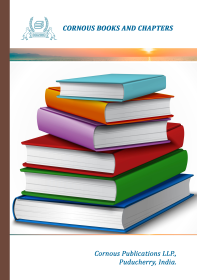

OPEN ACCESS | Published on : 17-Oct-2025 | Pages: 187-205 | Doi : 10.37446/volbook092024/187-205
Mushrooms are macroscopic fruiting bodies produced by ascomycete and basidiomycete fungi during their sexual reproduction cycles. Mushroom composition includes 85–95% moisture, 35–70% carbohydrates, 15–34.7% protein, 10–20% fat, 6–10.9% minerals, and 3–8% nucleic acids. It also has an abundance of vitamins, including 92–144 mg of ascorbic acid, 6.7–9.0 mg of riboflavin, biotin, and 1.4–2.2 mg of thiamine per 100 grams of dry weight, among others. The use of mushrooms as a source of physiologically active compounds with possible medical benefits, including antimicrobial, immune-modulating, antioxidant, antiviral, and hypocholesterolemic properties, has grown in popularity recently. The significance of mushrooms lies in their capacity to generate a wide range of extracellular enzymes that transform different types of agricultural waste into valuable myco-medicinals and high-value foods. Therefore, mushrooms, with their abundant diversity constitute a cost-effective means, both of supplementing the nutrition of humankind and in alleviating the sufferings. This chapter discusses about some common edible and large scale cultivated mushrooms include Paddy straw mushroom - Volvariella spp, Oyster mushroom - Pleurotus spp., Button mushroom - Agaricus spp, Milky mushroom - Calocybe spp., Shiitake mushroom Lentinulla spp. and Jew’s ear mushroom - Auricularia sp. The present communication deals with importance of mushrooms, taxonomy of mushroom and their morphology with different developmental stage.
Edible mushrooms, Biology, Morphology, Importance of mushrooms
Ahlawat, O. P., & Tewari, R. P. (2007). Cultivation technology of Paddy straw mushroom (Volvariella volvacea) (Technical Bulletin). National Research Centre for Mushroom (Indian Council of Agricultural Research) Chambaghat, Solan-173 213 (HP).
Alam, N., Khan, M. A., Hossain, M. S., & Amin, M. R. (2007). Nutritional analysis of dietary mushroom Pleurotus florida and Pleurotus sajor-caju (Fr.) singer. Bangladesh Journal of Mushroom, 1(2), 1–7.
Aruna, J. K. (2020). Nutritional and antioxidant significance of selenium-enriched mushrooms. Kora Bulletin of the National Research Centre, 44, 34. https://doi.org/10.1186/s42269-020-00289-w
Bahl, N. (2006). Morphology of mushrooms. In Handbook on Mushrooms (4th ed., pp. 21–25). Oxford and IBH Publishing.
Chang, S. T. (1990b). Mush J. 295, 422–423.
Chang, S. T., & Miles, P. G. (2004). Mushrooms: Cultivation, nutritional value, medicinal effect, and environmental impact. CRC Press.
Horgen, P. A. (1992). Application of biotechnology to the button mushroom, Agaricus bisporus. In J. R. Kinghorn & G. Turner (Eds.), Applied molecular genetics of filamentous fungi (pp. 191–200). Blackie and sons, Ltd.
Hossain, M. S., Alam, N., Amin, S. M., & Basunia, M. A. (2007). Essential fatty acid contents of Pleurotus ostreatus, Ganoderma lucidum and Agaricus bisporus. Bangladesh Journal of Mushroom, 1, 1–7.
Kirk, P. M., Cannon, P. F., Minter, D. W., & Stalpers, J. A. (2008). Dictionary of the fungi (10th ed.). CABI.
Krishnamoorthy, S., Akkanna, & Balan, V. (2015). A comprehensive review of tropical milky white mushroom (Calocybe indica P&C). Mycobiology, 43(3), 184–194. https://doi.org/10.5941/MYCO.2015.43.3.184
Kumar, K., Mehra, R., Guiné, R. P. F., Lima, M. J., Kumar, N., Kaushik, R., Ahmed, N., Yadav, A. N., & Kumar, H. (2021). Edible mushrooms: A comprehensive review on bioactive compounds with health benefits and processing aspects. Foods, 10(12), 2996. https://doi.org/10.3390/foods10122996
Ogidi, C. O., Oyetayo, V. O., & Akinyele, B. J. (2020). An introduction to mushroom. In Wild medicinal mushrooms: Potential applications in phytomedicine and functional foods. Intech Open.
Petruzzello, M. (2023). Shiitake mushroom. In Encyclopedia Britannica. Retrieved from https://www.britannica.com/science/shiitake-mushroom
Rahi, D. K., & Malik, D. (2016). Diversity of mushrooms and their metabolites of nutraceutical and therapeutic significance. The Journal of Mycology, 18. https://doi.org/10.1155/2016/7654123.7654123
Roy, G. (1969). Mushroom growing for everyone. Faber.
Sánchez, C. (2004). Modern aspects of mushroom culture technology. Applied Microbiology and Biotechnology, 64(6), 756–762. https://doi.org/10.1007/s00253-004-1569-7
Seo, D. J., & Choi, C. (2021). Antiviral bioactive compounds of mushrooms and their antiviral mechanisms: A review. Viruses, 13(2), 350. https://doi.org/10.3390/v13020350
Subbiah, A. K., & Balan, V. (2015). Comprehensive review of tropical milky white mushroom (Calocybe indica P&C). Mycobiology, 43(3), 184–194.
Tagkouli, D., Kaliora, A., & Bekiaris, G. (2020). Free amino acids in three Pleurotus species cultivated on agricultural and agro-industrial by-products. Molecules, 25(17), 4015. https://doi.org/10.3390/molecules25174015
Vikineswary, S., & Chang, S. T. (2013). Edible and medicinal mushrooms for sub-health intervention and prevention of lifestyle diseases. Tech Monitor, 33–43.
Xiang, Q., Adil, B., Chen, Q., Gu, Y., Zeng, X., & Li, X. (2021). Shiitake Mushroom (Lentinula edodes (Berk.) Sing. Breeding in China. In J. M. Al-Khayri, S. M. Jain, & D. V. Johnson (Eds.), Advances in plant breeding strategies: Vegetable crops (1st ed., Vol. 3, pp. 443–476). Springer.
Zeb, M., & Lee, C. H. (2021). Medicinal properties and bioactive compounds from wild mushrooms native to North America. Molecules, 26(2), 251. https://doi.org/10.3390/molecules26020251